1. Which two statements are true about the DHCP server functions? (Choose two.)
- When a client requests an IP address, the DHCP server searches the binding table for an entry that matches the MAC address for the client. If an entry exists, the corresponding IP address for that entry is returned to the client.
- Clients can be assigned an IP address from a predefined DHCP pool for a finite lease period.
- DHCP services must be installed on a dedicated network server to define the pool of IP addresses available to the clients.
- The DHCP server can answer requests and assign IP addresses for a particular subnet only.
- Each subnet in the network requires a dedicated DCHP server to assign IP addresses to the host on the subnet.
- The DHCP provides clients with an IP address, subnet mask, default gateway, and domain name.
2. Refer to the exhibit. What does the string 10.10.10.0 used after the ip dhcp pool command specify?

- name of the DHCP pool
- pool of IP addresses available for lease
- range of excluded IP addresses
- IP subnet where the DHCP server resides
3. Which three statements about DHCP are true? (Choose three.)
- DHCP messages use UDP as a transport protocol.
- The DHCPOFFER message is sent by the DHCP server after receiving a DHCPDISCOVER message from a client.
- DHCP uses ports 67 and 68.
- The DHCPREQUEST message is sent by a DHCP client to locate a DHCP server.
- The DHCPACK message is sent by the DHCP server to provide the DHCP client with the DHCP server MAC address for further communication.
- All DHCP communications are broadcast.
4. Refer to the exhibit. Router R2 is configured as a DHCP server. What would happen when Host A sends a DHPC request to the DHCP server?
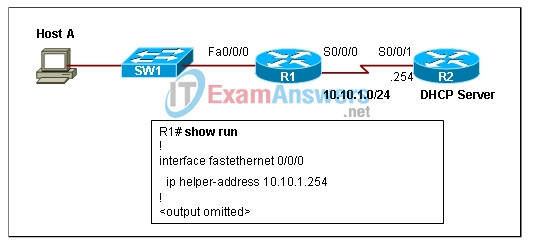
- The request is dropped by router R1.
- The request is forwarded to the DHCP server.
- The request is forwarded to the DHCP server, but the DHCP server does not respond with an IP address.
- Router R1 responds with an IP address.
5. Refer to the exhibit. Based on the output shown, which statement is true regarding this DHCP exchange?

- The client was successfully configured with the address 10.1.0.3.
- The DHCP server offered the address 10.1.0.3 to the client.
- The client requested 10.1.0.3 from the server.
- The DHCP server could not ping 10.1.0.3.
6. Refer to the exhibit. Based on the output shown in the exhibit, which statement is correct concerning the NAT configuration?
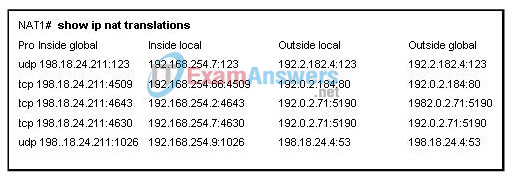
- Static NAT is configured.
- Dynamic NAT is configured.
- PAT is configured.
- NAT is incorrectly configured.
7. If an administrator chooses to avoid using NAT overload, what is the default timeout value for NAT translations?
- 1 hour
- 1 day
- 1 week
- indefinite
8. Match each characteristic on the left to the corresponding NAT technique on the right.
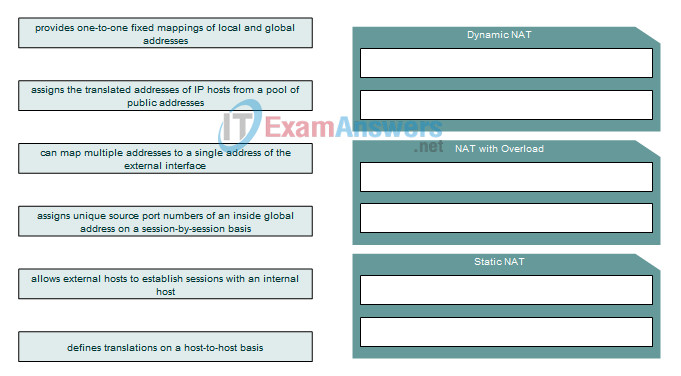
Answer
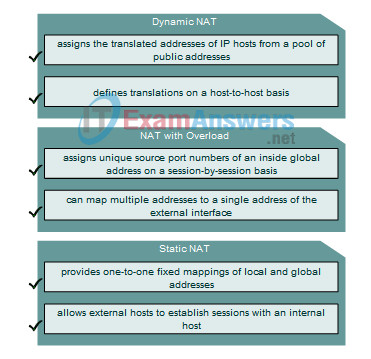
9. Refer to the exhibit. Which host or hosts will have their addresses translated by NAT?
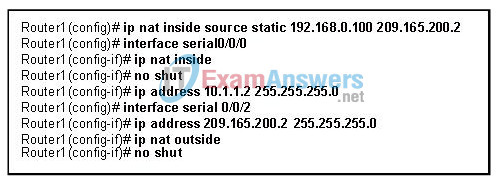
- 10.1.1.2
- 192.168.0.100
- 209.165.200.2
- all hosts on the 10.1.1.0 network
- all hosts on the 192.168.0.0 network
10. Refer to the exhibit. Which addresses will be translated by NAT?
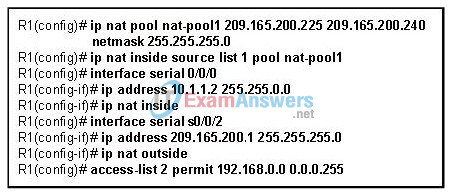
- 10.1.1.2 – 10.1.1.255
- 192.168.0.0 – 192.168.0.255
- 209.165.200.240 – 209.165.200.255
- only host 10.1.1.2
- only host 209.165.200.255
11. Refer to the exhibit. Web Server 1 is assigned a single IP address of 192.168.14.5/24. In order for hosts from the Internet to access Web Server 1, which type of NAT configuration is required on Router1?
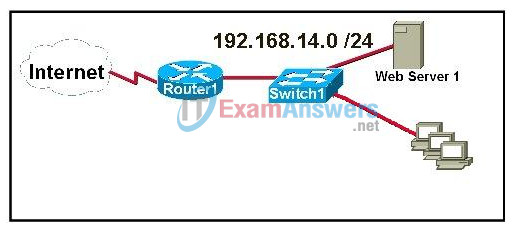
- static NAT
- dynamic NAT
- NAT overload
- port forwarding
12. Which NAT solution allows external users to access an internal FTP server on a private network?
- dynamic NAT
- NAT with overload
- port forwarding
- static NAT
13. Refer to the exhibit. Given the debug output from a Cisco router, what kind of address is 24.74.237.203?

- inside local
- inside global
- outside local
- outside global
14. Which two statements accurately describe the RIPng routing protocol? (Choose two.)
- RIPng has a limit of 15 hops.
- RIPng is a link-state routing protocol.
- RIPng uses UDP port 238 for updates.
- RIPng uses poison reverse.
- RIPng forwards IPv6 broadcasts.
15. Which two methods of assigning an IPv6 address to an interface are automatic and can be used in conjunction with each other? (Choose two.)
- DHCPv6
- stateless auto-configuration
- EUI-64
- static assignment
- DNS
16. Drag the IPv6 command on the left to the appropriate description on the right.
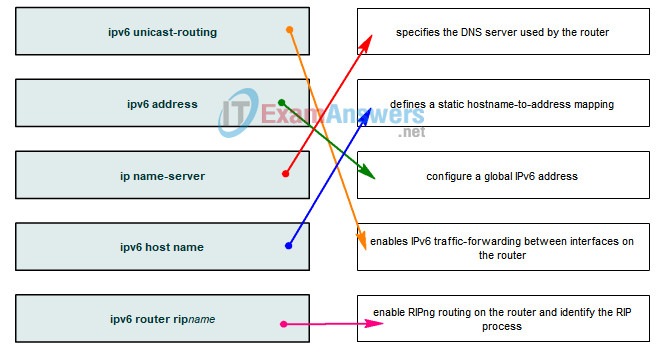
17. Refer to the exhibit. Which three items are equivalent representations of the full IPv6 address? (Choose three.)

- 2031:300::C0:8:130B
- 2031:0:300::C0:8000:130B
- 2031:0:3::C0:8000:130B
- 2031:0:0300:0:0:C0:8000:130B
- 2031::300:0:0:0C0:8000:130B
- 2031::0300::C0:8::130B
